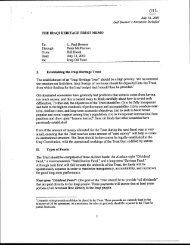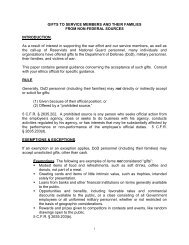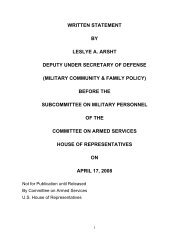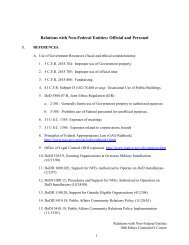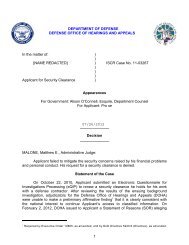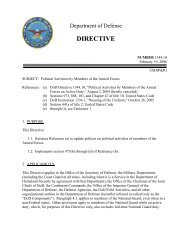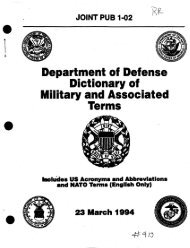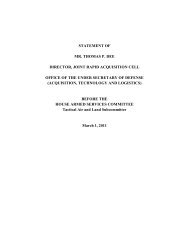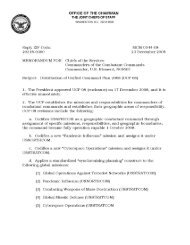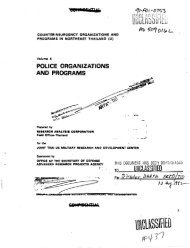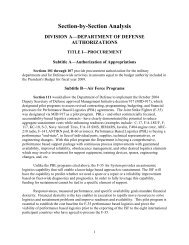dod tactical herbicide sites - United States Department of Defense
dod tactical herbicide sites - United States Department of Defense
dod tactical herbicide sites - United States Department of Defense
You also want an ePaper? Increase the reach of your titles
YUMPU automatically turns print PDFs into web optimized ePapers that Google loves.
Administration (Tactical Herbicides were the responsibility <strong>of</strong> the <strong>Defense</strong> SupplyAgency).By 1966, the AFPCB strictly controlled the kinds and forms <strong>of</strong> pesticides available under“Federal Specifications” and on the military supply list. New pesticides, before beingconsidered by the Board, had to be recommended by the US <strong>Department</strong> <strong>of</strong> Agriculture,the Fish and Wildlife Service, or the Public Health Service, and the proposed use had tohave been approved by all three <strong>of</strong> these organizations. In February 1967, the FederalCommittee on Pest Control (FCPC) was established. All Federal pest control activitieswere placed within the purview <strong>of</strong> the Committee. The Committee was composed <strong>of</strong> twomembers from each <strong>of</strong> the <strong>Department</strong>s <strong>of</strong> Agriculture; <strong>Defense</strong>; Health; Education, andWelfare; and Interior. Before a pesticide was approved for use in the <strong>United</strong> <strong>States</strong>, or bya Federal Agency, it had to be reviewed by the FCPC. The DoD’s “Tactical Herbicides”were exempt from this approval and oversight process. However, all other <strong>herbicide</strong>sused by the <strong>Department</strong> <strong>of</strong> <strong>Defense</strong> were required to meet this approval process. Thesignificance <strong>of</strong> this action was that <strong>herbicide</strong>s used in 1967 to 1970 on the more than 600military installations managed by the <strong>Department</strong> <strong>of</strong> <strong>Defense</strong> required approval by boththe AFPCB and the FCPC (after 1970, the registration and oversight <strong>of</strong> commerciallyavailable pesticides was the responsibility <strong>of</strong> EPA). This requirement applied to<strong>herbicide</strong>s used in Vietnam that were NOT TACTICAL HERBICIDES. Thus, <strong>herbicide</strong>sused on Allied Bases in Vietnam around buildings, in equipment storage <strong>sites</strong>, and alonginterior roads came under the requirements <strong>of</strong> the AFPCB. The responsibility for thepurchase and application <strong>of</strong> commercial pesticides on these installations was the BaseCivil Engineer, NOT the Army Chemical Corps. Tactical Herbicides were NOT approvedfor these uses. The insecticides used in Operation FLYSWATTER (the aerial application<strong>of</strong> insecticides to control mosquitoes in Vietnam) were under the Military’s DiseasePrevention Program and were approved by the AFPCB.With the establishment and functioning <strong>of</strong> the AFPCB, anytime a DoD Military Base,e.g., Eglin AFB, Florida, Andersen AFB, Guam, or Osan AB, Korea, requested the use <strong>of</strong>a <strong>herbicide</strong> to control plant pests, the selection <strong>of</strong> the <strong>herbicide</strong> must have been approvedby the Board. Locally purchased pesticides were to be approved by the CommandEntomologist. Moreover, the application <strong>of</strong> the <strong>herbicide</strong> had to be done by a Board“certified” (trained) applicator, and with equipment that had been approved by theUSDA, and under the supervision <strong>of</strong> the Base Civil Engineer. The <strong>Department</strong> <strong>of</strong>Agriculture’s Agricultural Research Service (ARS), and the Cooperative State ResearchService (CSRS) provided critical support to the development <strong>of</strong> pesticides that weresubsequently recommended and approved for use by the AFPCB. The Board DID NOTwork with the chemical companies manufacturing the pesticides, rather, these materialswere evaluated by ARS, the various State University Experiment Stations, and the Stateand Federal Extension Services. In addition, AFPCB depended upon CSRS and itsUniversity-based research and extension system to prepare and publish manuals onpesticide use, plans for certification <strong>of</strong> pesticide applicators, and the disposal <strong>of</strong> oldpesticides and pesticide containers. The final statements on safety and environmentprecautions on the use <strong>of</strong> <strong>herbicide</strong>s commercially available to the military were11



